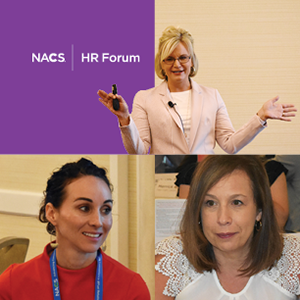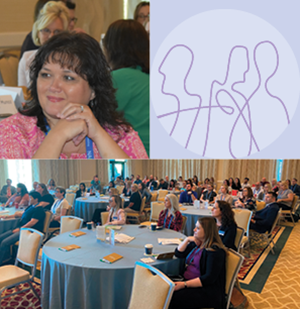Labor issues have always been at the forefront of the convenience retailing industry, and attendees at this year’s NACS HR Forum overwhelmingly agreed that hiring—and more so—retaining a quality workforce is the biggest HR challenge of 2022.
“To say that our businesses have evolved and that we are facing a talent shortage might be an understatement, and we need to continually re-evaluate how we are going to connect with our employees,” said Joanne Loce, managing partner, Fortify Leadership Group, and the forum’s moderator. “How do we attract, engage, develop and retain our most valuable asset—our people?”

To help attendees answer that question, Merrick Rosenberg, the CEO of Take Flight learning, kicked off the first day with a lively discussion of “the Birds”—four personality types that can help companies infuse personality into their culture and transform the way people work together and lead others.
RULES AND REGULATIONS
The pandemic completely upended the industry, and Megan Janes, an attorney with Fisher Phillips, presented attendees with COVID-19 information from a labor perspective. Janes polled the group, and while only 4% of attendees require their employees to be vaccinated against COVID-19, 82% have a written COVID-19 safety plan.
Janes expects face mask guidance and laws to continue to ebb and flow as states and localities alter their requirements based on current COVID-19 statuses. She also anticipates that workforce shortages will become an even bigger issue this coming winter, when infectious disease experts say that there could be a spike in virus cases. According to Janes, HR professionals should stay tuned for more legal changes in reaction to the anticipated uptick.
You’re up against a declining workforce participation rate, but you’re also up against growing competition for labor, and today’s worker understands that.
onvenience industry labor issues are as complex as they have ever been, according to Steven Bernstein, an attorney with Fisher Phillips, who also presented. In light of this unusual labor market, he challenged attendees to think about the kind of workforce they really want. Is it the same workforce they wanted five years ago? Do they want employees who want to stay long enough to retire, or is a quality employee who will stay for a few years or even just a year good enough?
Do we really want to retain an employee for 30 years?” he asked. “You have to be honest with yourself. You’re up against a declining workforce participation rate, but you’re also up against growing competition for your labor, and the worker of today understands that. They’re able to commoditize their labor in a way that workforces of yesterday never could.”
Bernstein says that workers don’t just request flexibility, they demand it in their schedules, and employers must accommodate them to stay competitive.
 The workforce has gotten so competitive that Bernstein has a client that sought legal advice on how to pay a bonus to applicants if they remove themselves from the labor pool long enough for their drug test results to clear. Bernstein is also seeing material handlers in warehouses earning $5,000 sign-on bonuses. “That’s the world we’re living in now,” he said. “That is your competition.”
The workforce has gotten so competitive that Bernstein has a client that sought legal advice on how to pay a bonus to applicants if they remove themselves from the labor pool long enough for their drug test results to clear. Bernstein is also seeing material handlers in warehouses earning $5,000 sign-on bonuses. “That’s the world we’re living in now,” he said. “That is your competition.”
EMPLOYEE VALUE PROPOSITION
For today’s workers, work no longer means a place they physically go to earn a paycheck. Work means wherever their car is while they’re busy ridesharing, or their living room while they’re crafting a career on social media.
So how can convenience retailers, where employees need to go to a physical place to work, attract the workforce of today? Having an employee value proposition (EVP), which tells future and current employees how they can benefit from working for you, can be the difference between a fully staffed store and scrambling to cover shifts.
“[Your company] already has [an EVP]. The difference is that some of you may be letting your employees define it 100% versus you articulating it for them,” said Chris McKinney, chief human resources officer, Victory Marketing/Sprint Mart.
 McKinney says that about 70% of employees admitted in surveys that they had one bad day at work and were inspired to apply for a job when they got home. “[An EVP shows] the foundation of how you are going to treat your people and how you expect your leadership to treat those around them,” said McKinney. “Hopefully that resonates with the individual after they’ve had a difficult day.”
McKinney says that about 70% of employees admitted in surveys that they had one bad day at work and were inspired to apply for a job when they got home. “[An EVP shows] the foundation of how you are going to treat your people and how you expect your leadership to treat those around them,” said McKinney. “Hopefully that resonates with the individual after they’ve had a difficult day.”
The 70% who had a bad day could get a text from a competitor that evening, submit an application with two taps on their mobile device, and in the morning, they could be talking to someone with a job offer that pays 50 cents to a dollar or more higher an hour.
“An individual that is not invested in your company or has no idea how the company is going to treat them is just going to leave for the money,” said McKinney. “[A fully articulated employee value proposition] needs to be woven into the fabric of the company as well and not just words on a page.”
According to Loce, who presented with McKinney, the building blocks for an EVP are the company brand, a commitment to the customer, values/purpose/mission, pay/ benefits and development opportunities. But overall, she says, an EVP spells out exactly what it means to the employee to work for your company.
“[An EVP] is a way for us to attract people, and the quickest way to spread this is word of mouth,” said Loce.
 QUICK TO HIRE
QUICK TO HIRE
TXB Stores Inc. recently overhauled its hiring process from one that took five days from interview to start to one that has an employee interviewed, onboarded and started in two days flat.
TXB completes the interview, background, hiring and onboarding in one day. “When [an employee] leaves, we hand [them] a schedule,” said Nathan Graham, director of human resources, TXB.
TXB shepherds potential employees through a four-step process. The first step is a store tour. When a job candidate walks through the door, a current TXB team member (not a manager) greets them and walks them through the store. They stop at the fountain drink area first, where the team member explains that all employees get a free drink during their shift, and the candidate gets a free drink. During the brief tour, Graham said, there is one-on-one conversation but no interview questions, and the team member is introducing the candidate to everyone working that day.
After the store tour, the candidate is handed off to another employee. Both sit down in the store, and the employee leads the candidate through a structured, five-to six-question interview process.
Next, the candidate is handed off to another employee who leads the candidate through a realistic job preview (RJP)—a 10-minute shadow process to show exactly the tasks required of the job.
The final step for the candidate is to speak with the store manager, who asks a few parting questions. At this point, the two employees who spoke with the candidate and led them through the RJP have given their approval. The store manager then extends a job offer.
“When the offer is made, the candidate has met every staff member on shift that day, so when he or she shows up for day one, they already have friends,” said Graham.
 Every TXB store that has implemented this hiring process has seen reduced turnover, Graham says. Overall, the company has seen a 12% decrease in turnover over the past six months.
Every TXB store that has implemented this hiring process has seen reduced turnover, Graham says. Overall, the company has seen a 12% decrease in turnover over the past six months.
Other sessions included a presentation by Kum & Go about leveraging a partnership between learning and development and DEI to drive culture change for embedded inclusion and equity. In addition, Thorntons shared how culture guides the retailer’s investment in leadership development, how it engages and grows field operations team members, and how Thorntons focuses on developing its corporate staff.
Turnover & Benefits
Jayme Gough, NACS’ research manager, offered HR Forum attendees a first look at the newly released NACS State of the Industry Compensation Report of 2021 Data, and reported that total turnover for the convenience retailing industry was 150%—the highest it has been since 2012. The full-time employee turnover rate is at 118.8%, and the part-time employee turnover rate is at 181.6%.
“We expected the turnover rate to be high in 2021, but 181.6% is a huge number,” said Gough.
She also noted that 87% of convenience store retailers offer health insurance to their full-time hourly associates. Dental is offered by 81%, vision coverage is offered by 76% and prescription drug coverage is offered by 83% of convenience retailers. “Health insurance is no longer a nice-to-have, it’s a need-to-have,” said Gough. “This is a baseline benefit, and it will not differentiate you from your competition.”
Other benefits expected by potential employees include remote work, flexible hours and unlimited paid time off. Benefits that can set an employer apart include employer-paid health care, four-day workweeks, wellness stipends, cash bonuses and child care.
Gough also said that U.S. job openings are at a 20-year high, and the national quit rate is at a record high of 2.9%. She also calculated that there are about 3.9 million people missing from the workforce since 2020. “That’s more people than our entire industry employs,” said Gough.
To purchase the NACS State of the Industry Compensation Report of 2021 Data, visit www.convenience.org/compreport.